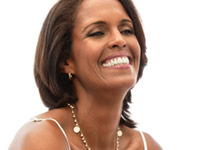Staying Fit
Since turning 55, I've come to view the lines on my face and neck the same way I think of the weeds in my garden: an annoyance best discouraged with diligent maintenance. Twice a day I lather with a $47 "age-defying" collagen cream. Last year a couple of rounds of Botox injections smoothed the crease between my eyebrows — but now it's back, and if I had an extra $25,000 I might go all the way and have a face-lift.


Photo Gallery
Not everyone is seeking the fountain of youth: Check out our slideshow featuring people in their 50s, 60s, 70s and 80s, who are comfortable with who they are and how they look.
Photo galleries:
But that's me, a member of the American demographic that sociologists say feels the most pressure to look younger: unmarried, post-50 women. I'm also part of another pressured group: professionals seeking job promotions. I worry that the older I appear, the more likely my 30-something friends are to lose interest in me, that employers might not hire me, that men will no longer find me attractive. The pressure further mounts thanks to where I live — image-obsessed Los Angeles — where "stars" like Kim Kardashian are idolized. On the Westside there seem to be more plastic surgeons per square mile than dentists.
Even outside L.A., few are immune to our society's obsession with youthful appearance, though how we deal with that varies from the rational — "I can't stop aging, so why worry?" — to the ridiculous. No offense to Angelina Jolie, but her bee-stung lips (which are purportedly natural) fueled a now passé plastic surgery craze that frequently produced profiles akin to Donald Duck's.


AARP Membership— $12 for your first year when you sign up for Automatic Renewal
Get instant access to members-only products and hundreds of discounts, a free second membership, and a subscription to AARP the Magazine.
Many of us (at least until we're in our later 60s, the experts say) adopt a proactive "It's better to do something than nothing" approach. In 2010, even as the economy still floundered, American consumers spent $832 million on antiaging skin creams and underwent more than 13 million cosmetic procedures, up 5 percent from 2009. Though the majority of those who opted for surgery were female, the number of face-lifts performed on men jumped 14 percent during that time period. Twenty-eight percent of the cosmetic procedures performed in 2010 were on 51- to 64-year-olds — second only to the 35- to 50-year-old age group.
"Since looking old affects our social status, we want to keep passing for younger," says Toni Calasanti, Ph.D., a sociology professor in Virginia Tech's College of Liberal Arts & Human Sciences and coauthor of Gender, Social Inequalities, and Aging. So we dye our hair, watch our weight, bleach our teeth, and cover up facial lines with cosmetics or smooth them out with plastic surgery. Medical intervention has gone from questionable to acceptable: Half of all Americans, regardless of income, now say they approve of it.

































































More on entertainment
11 Instant Style Tricks That Dress Up Any Outfit
Upgrade your look with some unexpected pairings